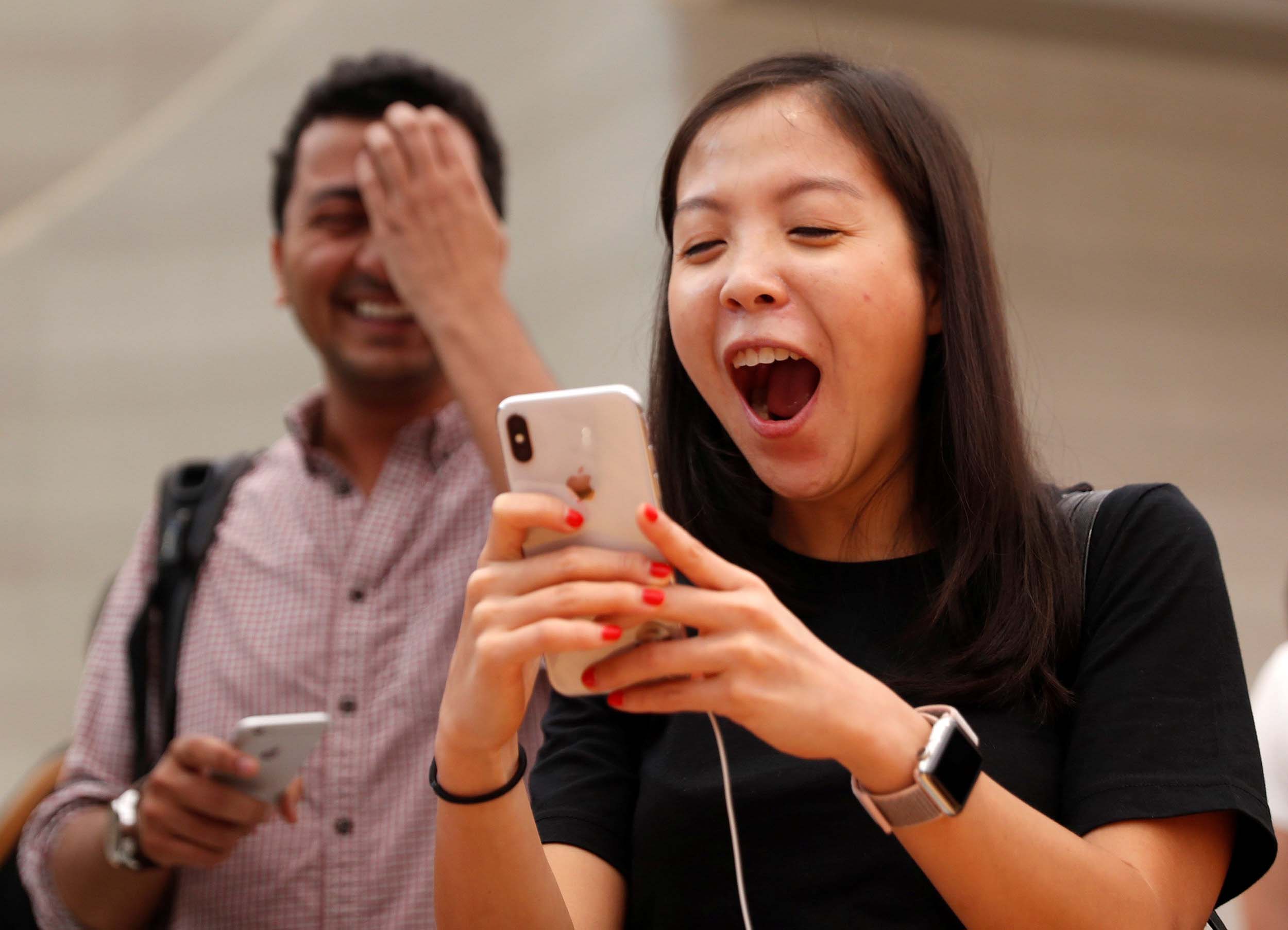花式测评出炉,这些是最有趣的iPhone X刷脸大法
|
谁曾想到,智能手机出现会导致手机通话减少?谁又能想象到,伴随着联网移动设备普及,印刷需求会随之增长?谁能预计到,社交媒体会成为媒介消费的主要形式? 新技术发布以前在实验室可以尽情测试,设想各种使用情境。但如果遇到意想不到的情况,自然也就难未雨绸缪。 所以,看看iPhone X引起怎样的反响应该会很有趣。苹果公司新出的这款智能手机增加了面部识别功能Face ID。用户可以通过刷脸解锁手机,不再需要输入密码或按指纹。 不少测评人士已经抢先一步,全方位尝试了Face ID的功能。测试结果啊,怎么说呢,真是挺有意思的。以下是一些最好玩的例子。 |
Who would have thought that the introduction of the smartphone would lead to a decline in phone calls? Who would have imagined that the proliferation of Internet-connected mobile devices would correspond with an increase in printing? Who would foresee that social media would become a primary mode of media consumption? You can test as many use cases as you can think of in the laboratory before you introduce a new technology, but naturally, you can’t prepare for the ones you can’t imagine. So it’s with great fascination that the world watches the rollout of Apple’s iPhone X, which includes Face ID, a facial recognition security feature that allows you to use your face, rather than your thumbprint or passcode, to log into your mobile device. Early reviewers are already putting Face ID through its paces, and the applications are, how should we say, interesting. Here’s a look at some of the most notable. |

|
可能难以辨别双胞胎。 美国媒体《华尔街日报》和Business Insider 分别请了三胞胎和双胞胎测试Face ID能否准确辨别用户。结果并不一致。《华尔街日报》的测试中,8岁三胞胎骗过了Face ID,Business Insider的测试中,双胞胎没能蒙混过关。 《华尔街日报》的记者乔安娜·斯特恩在测试报道中写道:“骗过面部识别系统后,三胞胎感觉更多是兴奋,倒没怎么担心兄弟可能打开自己的手机。”斯特恩认为:“Face ID仍然安全、快速、可靠,而且使用很方便。” 强光照射下识别效果可能不好。 《财富》杂志的科技与商业报道记者丹·雷辛格指出,iPhone X各种先期测评显示,在光线明亮的环境下,Face ID的识别效果看来比预期好,但阳光直射或者光线变化的时候可能出错。 生物识别技术专家凯文·鲍耶尔对雷辛格说,没什么可担心的。“当然,有些特殊环境下可能出问题,比如大中午的(美国加州东部)死亡谷或者什么地方。但如果正常日照下识别也能出错,才会让我惊讶。”鲍耶尔这样解释。 但光线极差时表现良好。 你可能会惊奇地发现,面部识别技术在几乎漆黑的环境下还能识别。但要是知道Face ID识别的原理是红外线,就会感觉正常了。 美国科技媒体CNET高级编辑斯科特·斯特恩在测评文章中写道:“在接近伸手不见五指的房间里,仅凭iPhone屏幕发出的光线,Face ID也可以准确识别。”而后他又加了一句:“我们还需要做更多测试,看看Face ID的极限。” 可能无法识别戴着围巾或者帽子的用户。 跟美国机动车辆管理局对驾照相片的要求差不多,异物遮脸后Face ID就认不大出来了。美国科技博客Gizmodo的博主亚历克斯·克兰茨在文章中写道:“要顺利用Face ID解锁,就得把围巾拉到鼻子下,帽沿要高过眉毛。”他指出,冬天用户可能(对这种硬性要求)感到不便。 对戴眼镜用户的识别效果不稳定。 CNET和Gizmodo都对Face ID测试了戴眼镜用户的识别效果。结果有好有坏:Gizmodo的克兰茨说,系统只花了几小时就让“Face ID的模式适应了我脸上的大眼镜”。他认为,Face ID需要时间学习。CNET的斯特恩说得更简练:“我戴墨镜不影响Face ID识别。” 不能自动解锁手机。 别指望Face ID会像之前的指纹识别功能Touch ID一样自动解锁手机,那样跨越力度有点大。CNET的斯特恩指出,为了避免误用,“识别我的面部以后,手机只是‘准备好解锁’。我还得用手指划过屏幕才能完成解锁。多花不了什么时间,但多出来的步骤意味着不会立刻解锁。” 有时可能因为面部识别失败,无法再使用Face ID功能。 和Touch ID一样,Face ID如果未能识别面部,就会需要密码解锁,影响新功能对用户的吸引力。CNET的斯特恩写道:“尝试Face ID解锁失败后,iPhone X有时会要求我重新输入密码,输入正确的密码前都无法使用Face ID。如果你用过Touch ID就明白,这就像手指沾水的时候解锁失败一样。” 先期测评仍得到正面评价。 虽然测评者只能使用一天iPhone X,但大多数人都认为,Face ID几乎适合现实世界中所有场景。 亲自做了先期测评后,《时代》杂志记者丽莎·艾迪西克在文章中写道:“无论我是在明亮的办公室,在漆黑的屋里,还是戴上墨镜,Face ID都很快认出了我。三星的智能手机Galaxy S8+可没这么厉害。” 美国科技媒体The Verge的记者尼雷·帕特尔则换了一种方式:“好消息是大部分情况下Face ID很好用,坏消息是也会有失灵的时候。” (财富中文网) 译者:Pessy 审稿:夏林 |
Identical twins could pose a problem. Both the Wall Street Journal and Business Insider tapped twins (and in one case, triplets) to see if Face ID could pass muster. Results were mixed. The Journal‘s 8-year-old triplets foiled the facial recognition system while Business Insider’s twins did not. “The three seemed far more excited about defeating the system than afraid their brothers might one day break into their iPhones,” the Journal’s Joanna Stern writes. Still, “FaceID is secure, fast, reliable and very easy to use.” It may not work as well in extreme light. As Fortune’s own Don Reisinger notes, Face ID appears to work better than expected in very bright environments, according to various early reviews of Apple’s iPhone X, but direct sunlight or changing conditions could trip it up. It’s nothing to worry about, biometric technology expert Kevin Bowyer tells Reisinger. “Sure, there is probably something in some extreme conditions—maybe high noon in Death Valley or something,” he says. “But I will be surprised if anyone had documented any large problem in normal sunny conditions.” …but it thrives in extreme dark. You might be surprised that facial recognition technology works in almost complete darkness—until, that is, you learn that Face ID uses infrared light to function. “Face ID worked perfectly in an almost completely dark room, too, lit only by the iPhone’s screen,” CNET’s Scott Stein wrote in his review, before adding: “We’ll still need to do a lot more testing to see what Face ID’s limits are.” It may not be scarf or hat-friendly. Much like the DMV for a driver’s license photo, Face ID isn’t too keen on foreign objects blocking your face. “Face ID demands you lose the scarf over your nose or the hat pulled down past your eyebrows,” Alex Cranz writes at Gizmodo, noting that people in winter climates may find this to be a (necessary) inconvenience. …and there are mixed reviews about eyeglasses. Both CNET and Gizmodo tested Face ID for eyeglasses. The results were mixed: Gizmodo’s Cranz writes that the system took mere hours “for the Face ID module to understand the big planes of plastic in front of my face,” noting that it learns over time. CNET’s Stein was more succinct: “Face ID didn’t mind my sunglasses.” It doesn’t automatically unlock your phone. Don’t expect that Face ID will simply unlock your phone automatically the way Apple’s Touch ID did—that’s a bit aggressive. To prevent misuse, “The phone ‘readies for unlock’ when it recognizes my face,” CNET’s Stein notes. “The iPhone still needs my finger-swipe to finish the unlock. It’s fast, but that extra step means it’s not instantaneous.” And sometimes, you can get locked out of facial recognition entirely. Like Apple’s Touch ID, Face ID falls back on the passcode in the event facial recognition fails, muting the allure of the new technology. “The iPhone X occasionally asked me to re-enter the passcode after a failed Face ID attempt, then locked out further Face ID efforts until I entered the passcode again,” CNET’s Stein writes. “If you’ve used Touch ID, this will remind you of trying to use an iPhone with wet fingers.” Still, early reviews are positive. Though reviewers have only had Apple’s iPhone X for one day, most have come to the conclusion that Face ID delivers in almost every reasonable real-world situation. “Face ID recognized me quickly whether I was in a brightly lit office, in a completely dark room, or wearing sunglasses,” Time’s Lisa Eadicicco writes in her hands-on early review. “That wasn’t so with Samsung’s Galaxy S8+.” The Verge‘s Nilay Patel put it another way: “The good news is that Face ID mostly works great. The bad news is that sometimes it doesn’t.” |











